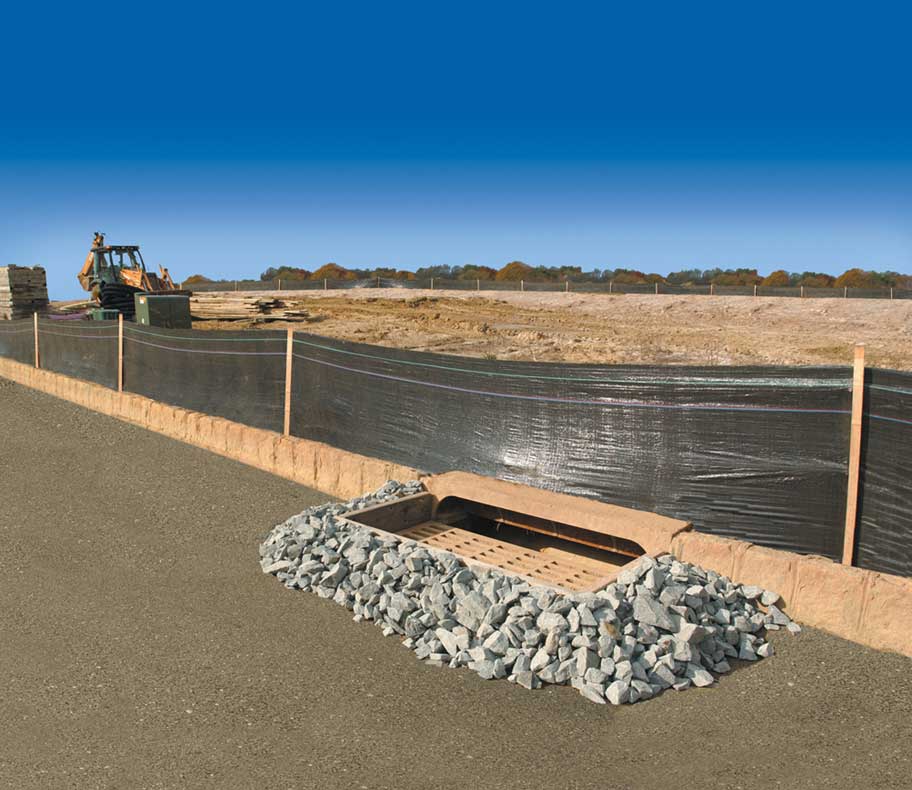Little was done in most of the USA to control sediment from construction sites prior to 1992. A few states had regulations; most did not. Regulations promulgated that year as a result of amendments to the Clean Water Act (CWA) and the National Urban Runoff Program (NURP) put Federal mandates in place to control pollution in stormwater leaving construction sites.
How Silt Fences Are Used on a Construction Site
From that time on, builders began to use erosion and sediment control measures on sites. One of the most commonly used systems was the silt fence—a fabric made of synthetic fibers and fastened to posts driven into the ground. Silt fences have historically been used in all the following applications at construction sites:
- to impede the flow of water carrying silt toward the site boundary
- to redirect the flow of silt-laden water to a sediment basin
- to route clean water through a construction site
- as perimeter controls around sites
- to protect existing or new storm sewer inlets from taking on sediment
- across ditches in or downstream of a construction site
Experience has shown that silt fencing is not appropriate for some of these uses. Still, it has been used all these ways and more since it was introduced to the construction industry.
Filtration by The Filter Fabric
If you are looking for architecture in Gold Coast, then you have to spend time and you always find an architect. One method by which the silt fence removes suspended soil particles is filtration. The fabric typically used for silt fencing is woven, just as a garment is (though some fabrics used for silt fence are non-woven, needle-punched fabrics). As a fabric, there will be openings between the fibers. Depending on the synthetic material used and the manufacturing process, the size of these openings varies.
A review of the Arkansas Highway and Transportation Department’s requirement for silt fence reveals that fifteen different fabrics, made by eleven different manufacturers, are allowed for what is called a “supported silt fence.” The “apparent opening size” of the fabric, as measured by ASTM standard D 4751, indicates that most or all particles larger than that size will be removed at the face of the fabric (i.e. “filtered out”). For these fifteen fabrics, the apparent opening size varies by a factor of 2.8:1. Obviously the performance in filtration will vary considerably based on the opening size.
Of course, the designer or specifier of silt fence cannot simply choose a fabric with a smaller apparent opening size, for the smaller the opening the lower the rate of water that passes through the fabric.
Sedimentation Upstream of the Silt Fence
In addition to providing filtration removal at the face of the fabric, the silt fence also reduces off-site discharge of sediment by promoting sedimentation. The restriction of water flow through the fabric causes a temporary sediment pond to form upstream of the fabric. When run-off arrives at this pond, the greatly reduced velocity of the water allows particles in the water to settle. If the conditions are right, these particles will settle all the way to the bottom and be removed from the water.
Various laws of science and engineering govern the settlement of particles in a pool such as is formed by a silt fence. While it is not common for rigorous calculations to be performed, still the silt fence produces sedimentation according to these laws and a general understanding of them is essential for proper use and siting of silt fence. The configuration of the fence on the site relative to the fall of the land is critical to prevent localized erosion along the fence bottom.
In the right conditions and for certain soil types, more sediment will be removed by sedimentation than by filtration.
Proper Design, Installation, and Maintenance Are Essential to Protect Water Quality
Experience has shown that the installation of the silt fence, and then proper and frequent maintenance, are essential if the fence is to work correctly. The bottom of the fabric must be embedded into the ground. Otherwise water will simply flow beneath the fabric, eliminating filtration and greatly reducing sedimentation. The posts that support the fence in place must be driven to the correct depth and spaced at the right distance along the fence line. Sediment that accumulates upstream of the fence must be removed from time to time, typically when it reaches one third to one half the height of the fabric.
The combination of filtration and sedimentation are at work at a silt fence to remove soil particles that are eroded from a construction site. Proper design, installation, and maintenance of a silt fence can have a great, positive impact on stream water quality at and downstream of a construction site.

